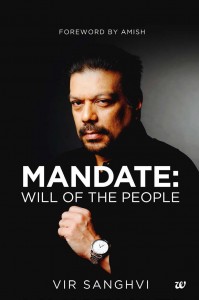Three Decades of India: The Mandate of a Media Man
I was wondering what Vir Sanghvi had been doing after that ignominious Nira Radia episode. A pleasant face among Indian journalists, Vir had/has to his credit many delectable columns on Indian politics and Indian cuisine as well as several TV productions and interviews along similar lines. Unlike many journalists in his generation, he knows what amount of humor he needs to add to his lines and like all delectable food writers he knows the pinch of salt required to prepare the best gastronomic features. Then came the expose of Nira Radia tapes and of the incestuous political shenanigans between politicos, crony capitalists, media mediators and journalists. Despite the remorse Vir expressed over his wrong sense of judgment and his inexcusable role in it as his friend Vinod Mehta said in Lucknow Boy, we aam admi believe that journalists are too pure to be defiled even once.
There were a few video QandA sessions on everything he could answer. Questions regarding, for examples, beef ban, book ban and ironies in Indian politics were tweeted to him and he answered to a select few of them in not more than twenty-minute-long video segments. But these segments may rank several points lower than his regular columns and books like Rude Food. Then came his book on Indian elections titled Mandate: Will of the People. Vir explains the reason it occurred to him to write the book in its introduction: he was asked to do a TV series for News X on Indian elections. And he travelled “from Thiruvananthapuram to Amritsar to try and put the show together.” Then it dawned on him that “the whole generations of Indians had no real understanding of the political history of the last three decades. Partly, this was because they had been deliberately misinformed. Partly, there was so little that was available to them in the form of popular history.” Hence, the book. He says his intention was ‘to produce a book that is well-informed and gets information as directly as possible from the principal players without trying to masquerade as a scholarly work.”
To be very frank, I got dissuaded by the arguments of Amish, the creator of Nagas, in the foreword to the book. While the right-wing economic policies and agendas were taken a pinch of salt by, to say the least, the right-wing historian Francis Fukuyama in his latest two series books on political order and while they are proven to be structurally skewed mechanisms by the likes of Thomas Picketty, Amish’s argument for right-wing economic policies cannot help being hackneyed. But the foreword helped this writer, who has yet to read his novels, in such a way that it proved I did not need to spend time for that.
The book offers rather interesting read on major political events such as Emergency, Indira Gandhi assassination, state sponsored anti-Sikh pogrom in 1984, Rajiv Gandhi assassination, Babari demolition which shook our confidence in not only the rule of law of the country but also the concepts and political values such as democracy and secularism, Mandal Commission recommendations and the ensuing agitations, the state sponsored genocide of Gujarat etc. Though, as is expected of him, Vir takes a right-of-the-centre position on all these issues, he offers us a rather enjoyable read of these major political events which, had they been attempted by someone less amusing than he, would have definitely bored us.
But there are certain right-wing moments in the book of which we must be so cautious as to take the pinch of salt. For example, during his narration on the Babari demolition, he let Advani off the hook and place the burden squarely on the shoulder of Narasimha Rao. Of course, the crime Rao committed was that of pathetic indifference to the extent of letting the crime and the criminals the breathing space to go ahead with the demolition plan, Advani was the instigator of the whole drama. According to Martha Nussbaum, the eminent professor of law at Chicago University, whose The Clash Within: Democracy, Religious Violence, and India’s future is an analytical exposition on all major issues that Vir deals with in his book, “BJP campaign videos showed Advani posing with a discus like Krishna, and with a bow and arrow like Ram; he and another minister were photographed conducting a sacred ceremony. In rural areas Advani tended to stress the devotional nature of his campaign; in Parliament and in urban discussions, the political themes.” So Advani played so many roles at a time that he can’t be pinned down on particular statement or remorse after the event. That is why despite his remorseful cry like ‘They (karsevaks) destroyed my movement’ as Vir quotes Promod Mahajan as saying, Advani’s attempt to save himself from blame failed to hold much water.
Secondly there is the much hyped image of liberal face of BJP v/s the BJP hawks. How could a cadre party trained in the courtyard of RSS have different faces simultaneously? Martha Nussbaum quotes historian Christophe Jaffrelot in this regard. “There clearly is a division of labor, with different politicians speaking in ways that appeal to different groups. A division of labor is not, however, a true division of policy.”
There is finally that old, hackneyed dichotomy: for facts, you knock on the door of a journalist. To tease the facts out, call the professor.























Connect
Connect with us on the following social media platforms.